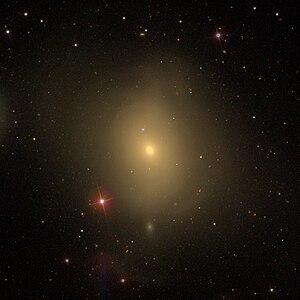Messier 85
| Galaxy data from Messier 85 |
|
|---|---|

|
|
| The galaxy Messier 85, image section from the SDSS | |
| AladinLite | |
| Constellation | Berenike's hair |
|
Position equinox : J2000.0 , epoch : J2000.0 |
|
| Right ascension | 12 h 25 m 24.1 s |
| declination | + 18 ° 11 ′ 29 ″ |
| Appearance | |
| Morphological type | SA (s) 0 + / pec |
| Brightness (visual) | 9.1 mag |
| Brightness (B-band) | 10.0 mag |
| Angular expansion | 7.1 ′ × 5.5 ′ |
| Position angle | 5 ° |
| Surface brightness | 13.0 mag / arcmin² |
| Physical data | |
| Affiliation | Virgo Galaxy Cluster, LGG 292 |
| Redshift | +0.002432 ± 0.000006 |
| Radial velocity | +729 ± 2 km / s |
|
Stroke distance v rad / H 0 |
(31 ± 2) · 10 6 ly (9.49 ± 0.66) Mpc |
| diameter | 105,000 ly |
| history | |
| discovery | Pierre Méchain |
| Discovery date | March 4, 1781 |
| Catalog names | |
| M 85 • NGC 4382 • UGC 7508 • PGC 40515 • CGCG 099-045 • MCG + 03-32-029 • VCC 798 • GC 2946 • h 1242 • KCPG 334A | |
Messier 85 (also known as NGC 4382) is a +9.1 mag bright galaxy with an area of 7.1 '× 5.5' in the constellation Haar der Berenike . Messier 85 was discovered on March 4, 1781 by the French astronomer Pierre Méchain .

High-resolution image of the center of Messier 85, taken with the help of the Hubble space telescope
The lenticular ( Hubble-type S0) galaxy M 85 is the northernmost galaxy of the Virgo galaxy cluster . The bar-spiral galaxy NGC 4394 with a magnitude of 11.2 mag, which can be found at a distance of 8 arc minutes , seems to be a real companion of M85, because both galaxies show the same redshift , which corresponds to a radial velocity of approx. 700 km / s.
On December 20, 1960, the type Ia supernova SN 1960R was discovered in Messier 85 .
Web links
Commons : Messier 85 - Collection of images, videos and audio files
- M85 at SEDS
- SEDS
- spectrum .de: amateur recordings [1]
Individual evidence
- ↑ a b c d NASA / IPAC EXTRAGALACTIC DATABASE
- ↑ a b c d e SEDS : NGC 4382
- ↑ Seligman
- ^ A b Searching NED for object "SN 1960R *". In: NASA / IPAC Extragalactic Database. Retrieved October 5, 2008 .
- ^ List of Supernovae. HARVARD-SMITHSONIAN CENTER FOR ASTROPHYSICS, accessed March 20, 2008 .


